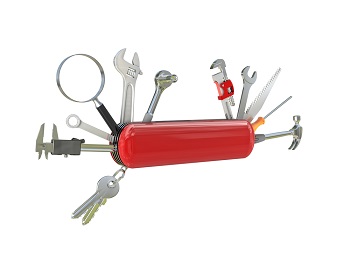Next, you must assign responsibility for strategic trade control within your enterprise. Delegating strategic trade control functions to the appropriate personnel in your enterprise is essential to ensuring that all the components of the ICP are executed properly. The inability to assign STC responsibilities to specific, empowered compliance personnel could result in their failure to perform key tasks and instances of non-compliance.
The purpose of this element is to ensure that all compliance-related functions, duties, and responsibilities in your enterprise are clearly defined, identified, and assigned; that the relevant positions and incumbents are known throughout the organization; and that there are internal records of these assignments that are routinely updated and distributed to employees.

Implementing this element requires your enterprise to complete three tasks:

Task 1: Selecting Personnel for STC Compliance Related Responsibilities
The organizational structure of an ICP refers to the hierarchy an enterprise establishes to guide and oversee the development, implementation, and day-to-day operation of the ICP. In order to designate the appropriate personnel, your enterprise must first assess the current organizational structure and operations and determine the most effective placement of the various STC compliance functions. Your enterprise should seek to determine the compliance responsibilities, location, and quantity of compliance personnel and whether compliance functions will be centralized or de-centralized within your enterprise.
Determine Compliance Functions
First, identify the STC responsibilities attributable to each position and function of your enterprise. Each STC compliance task should have a specific person assigned who is responsible for assuring that it is performed.
The following strategic trade control responsibilities should be delegated to appropriate personnel within your enterprise:
Adherence to STC policies and procedures is incumbent upon every employee within your enterprise, and all employees are likely to have some role to play in the STC compliance process.
Determine the Location of Empowered Compliance Personnel
As with the other “core” elements of an ICP, it is at your enterprise’s discretion to determine where STC compliance functions and personnel should reside. The size and location of your business will largely dictate the structure of your enterprise’s compliance functions. Larger enterprises (particularly MNCs) typically decentralize STC compliance responsibilities, by tasking an office or administrative department, but exercising sufficient corporate oversight to ensure compliance. Larger enterprises sometimes establish multiple compliance organizations – with an ICP Office that is responsible for day-to-day compliance, product classification, recordkeeping, and training, and another unit that is responsible for supervising the activities of the ICP Office and developing and maintaining the enterprise’s trade compliance policies. In some MNCs, it may be appropriate to create separate ICP offices or designate specific compliance personnel for each subsidiary, business unit, or affiliate. These individuals may be referred to as Trade Compliance Managers (TCM) or Trade Compliance Officers (TCO).
By contrast, small and medium-sized enterprises (SMEs) often choose to centralize the responsibilities for STC compliance in one or a few individuals. This may necessitate establishing an STC Compliance Committee, or if the size and activities of the enterprise warrant, simply task one individual with overall responsibility for STC compliance within the organization (commonly referred to as a Chief Compliance Officer). Where possible, it is recommended that your enterprise centralize key compliance functions (particularly SMEs). Many enterprises centralize the administration of training, recordkeeping, dissemination of regulatory material, notification of non-compliance, and audits. However, due diligence checks and transaction screening measures are usually performed by personnel throughout the enterprise.
Determine STC Compliance Assignments and Positions

Next, your enterprise must establish STC compliance positions. First, a single individual should be assigned a leadership role with overall responsibility for STC compliance functions within the organization. The individual charged with this responsibility should be a senior director, manager or other individual of corresponding status. This individual will carry personal responsibility for STC compliance within the enterprise and typically reports directly to the Chief Executive Officer (CEO) or Chief Operations Officer (COO). This individual is often referred to as the Chief Compliance Officer (CCO). The management of, and ultimate responsibility for, the enterprise’s ICP is vested in the CCO and this individual is generally responsible for coordinating compliance activities with other enterprise officials and/or departments that are involved in STC trade or compliance-related issues (e.g. legal, contracts, or shipping departments). For most enterprises, it is appropriate to name the empowered and authorized CCO in the compliance policy statement issued by management. Note: Depending on the legal structure of the enterprise (e.g. partnership or corporation), the CCO might be a member of the board of directors, a managing director or a managing partner.
Chief Compliance Officer
A Chief Compliance Officer's duties might include some or all of the following, but keep in mind that senior management or the CCO may delegate some of these responsibilities to other empowered compliance officials within the enterprise, when deemed necessary or appropriate.
Next, in support of the CCO, management may appoint capable support staff (as well as competent back-up personnel) that can oversee the day-to-day STC compliance functions of the enterprise. The CCO can be supported by the establishment of a STC Compliance Committee (usually staffed by management or department heads) and/or by Trade Compliance Managers / Officers (TCMs or TCOs) at each business unit.
Trade Compliance Managers / Officers (TCMs or TCOs)
TCM/TCOs maintain primary responsibility for all STC compliance requirements applicable to that specific business unit but may be further assisted by deputies where the size of the enterprise mandates it. TCMs/TCOs may be tasked with day to day operation of the ICP and responsibility for applying for STC licenses. In some firms, an authorization or written confirmation from a TCM/TCO is required before enterprise employees may export or transfer any item to another country. The TCM/TCO may determine whether a license/permit is required and, if it is required, initiate the process to obtain one from the national authorities. TCMs/TCOs should also have the authority to halt a transaction if there are non-compliance concerns. Finally, the TCO/TCM may act as the primary internal (for colleagues) and external (towards the national authorities) point of contact for STC compliance-related issues (in some enterprises this responsibility resides with the CCO).
To avoid potential conflicts of interest, empowered compliance officials should generally be positioned within the enterprise so their sources of salary, bonuses, and performance evaluations are separate from the business(es) or units they monitor. Trade compliance personnel should be independent of the sales and marketing departments and should have sufficient authority and discretion vested in them to prioritize STC compliance in the face of other potentially conflicting or competing business interests. Many enterprises have attempted to ensure the independence of their STC compliance personnel by placing them in the legal department or having them report directly to the CEO/President.
In addition to appointing a CCO, TCMs/TCOs, and/or a STC Compliance Committee or Office, your enterprise might also consider establishing other STC compliance positions. The following are some examples of possible STC compliance positions and the accompanying duties of each position:
Other Empowered Compliance Personnel
In all cases, the STC compliance hierarchy should be easily comprehensible, and there should be no confusion as to the line of responsibility and accountability stretching from the highest levels of management (President, CEO, board of directors, etc.) to the legal, HR, compliance, sales, marketing, and order-processing offices and staff members, as well as personnel not directly employed in a trade or compliance-related capacity. The organizational structure should be sufficiently clear so that employees know which office or individual(s) to consult if they have a question or concern related to strategic trade control compliance.
Determine the Optimal Number of STC Compliance Personnel
Irrespective of the type of organizational structure adopted by your enterprise, management should seek to ensure that STC compliance functions are staffed with appropriate and adequate personnel. Your enterprise should seek to ensure that a sufficient number of personnel are dedicated to STC compliance functions. To determine the optimal number of personnel required to properly staff the STC compliance functions within your enterprise, management should assess and estimate the demands posed in critical areas such as technical review, commodity classification, license applications, license implementation, transaction screening, internal security (physical and IT), training, recordkeeping, and internal audits.
The ultimate determination of how many personnel should be involved in STC compliance functions requires a thorough analysis of your enterprise. Specifically, the analysis should take the following factors and variables under close consideration when determining compliance staffing needs:
With these details in hand, your enterprise will be well positioned to quantify the number of personnel required to effectively manage STC compliance requirements and the ICP.
In addition, management should designate knowledgeable back-up personnel that can maintain the compliance structure in the temporary absence of key personnel. Backup personnel are essential during periods of employee turnover and your enterprise’s organizational structure documentation should include a description of the steps and procedures to be followed if someone with STC compliance responsibility is absent.
Note: The “Organizational Structure” link within the “ICP Implementation Aids” sub-section contains a contact list template, examples of compliance organizational charts, and a description of titles and responsibilities for various STC compliance positions.
Task 2: Document Compliance-related Positions, Assignments, and Roles
The STC organizational hierarchy should be transparent, and management should communicate it clearly to all employees in a format that is unambiguous and easily understood. Enterprises should draft and provide lists and/or charts to convey the organizational structure to all employees. Lists are superior for presenting specific strategic trade control compliance duties, while organizational charts are preferable for illustrating reporting lines and structures within the enterprise.
Your enterprise should consider documenting compliance-related positions by developing:
Note: These organizational charts and contact lists should be widely distributed throughout the enterprise and updated periodically to reflect staff changes. Lists and charts can be displayed and updated on the enterprise website, intranet and/or in internal publications.
STC Compliance: Incentives and Penalties
Your enterprise might also consider developing incentives for employees that meet and surpass their compliance responsibilities, such as enterprise-wide recognition or a raise in pay. Some enterprises will evaluate the compliance record of an employee during performance appraisals and factor it into promotion decisions. Similarly, an effective organizational structure will make the consequences for failing to meet one’s compliance responsibilities clear in the form of pre-established penalties or punishments. Punishments can range from a negative mark on an employee’s personnel evaluation to a demotion, or in more severe circumstances, employee termination. Moreover, your enterprise should inform all new and current employees that they will be subject to legal action for STC violations.
These incentives and penalties should be clearly defined and distributed to all new employees at the time of hiring and contained in new hire contracts and employee paperwork. The information should also be readily available to all employees – either through your enterprise’s intranet and/or in hard-copy with the human resources (HR) department.
Note: The “Organizational Structure” link within the “ICP Implementation Aids” sub-section contains a contact list template, examples of compliance organizational charts, and a description of titles and responsibilities for various STC compliance positions.
Task 3: Distribute the List of Responsibilities
Lastly, it is incumbent upon your enterprise to distribute an organizational chart identifying all personnel with strategic trade control-related responsibilities. Employees and customers should be made aware of the name of your enterprise’s Chief Compliance Officer (CCO) and other relevant empowered compliance officials and should be encouraged to direct questions or concerns to these individuals when they arise.
This information should be kept current to account for any changes in personnel or your enterprise’s business activities. When updates do occur, your enterprise should re-distribute the organizational chart to all concerned parties.